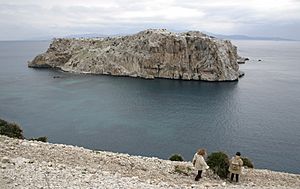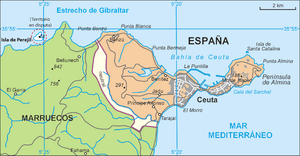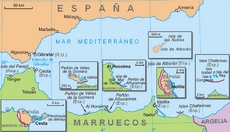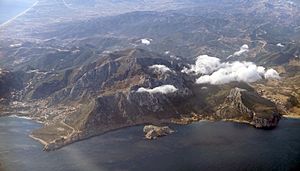Perejil Island facts for kids
| Disputed island Native name: Isla Perejil Tura / Toṛa تورة Parsley Island |
|
|---|---|
 |
|
| View of Perejil Island from the Moroccan coast with Spain on the horizon | |
| Geography | |
| Location | Strait of Gibraltar |
| Coordinates | 35°54′50″N 5°25′08″W / 35.91389°N 5.41889°W |
| Total islands | 1 |
| Area | 15 hectares (37 acres) |
| Highest point | 74 metres (243 ft) |
| Administered by | |
| Claimed by | |
| Demographics | |
| Population | Uninhabited |

Perejil Island (also called Parsley Island) is a tiny, rocky island. It is located very close to the coast of Morocco. The island is uninhabited, meaning no one lives there. Both Spain and Morocco claim the island as their own. This disagreement led to a short conflict between the two countries in 2002.
Contents
What's in a Name?
The Spanish name Isla de Perejil means "Parsley Island." Its original name in the Berber language is Tura. This word means "empty."
Sometimes, people mistakenly call it Laila. This happened because "the island" in Spanish is "la isla." When spoken with an Andalusian accent, it sounds like "lah ihla" or laíla. In Arabic, it is also called "Jazirat al-Ma'danus," which means "Parsley Island."
However, in Moroccan history, the island is only known as "Tura." The King of Morocco, Mohammed VI, used only the name "Tura" when he spoke about the island in 2002.
Where is Perejil Island?
This small island is located about 250 meters (820 feet) off the coast of Morocco. It is about 3 kilometers (1.9 miles) from the border of the Spanish city of Ceuta. Ceuta itself is 8 kilometers (5 miles) away. Mainland Spain is about 13.5 kilometers (8.4 miles) from the island.
Perejil Island is roughly 480 meters (1,575 feet) long and 480 meters (1,575 feet) wide. Its total area is about 15 hectares (37 acres). The highest point on the island is 74 meters (243 feet) above sea level.
A Brief History of the Island
In 1415, Portugal took control of Perejil Island. This happened at the same time they conquered the nearby city of Ceuta. Later, in 1580, Portugal came under the rule of the King of Spain, Philip I. This created a union of the two countries under one king.
When this union ended in 1640, Ceuta remained under Spanish rule. However, the ownership of Perejil Island has been debated between Morocco and Spain ever since.
The 2002 Island Incident
Most people in Spain and Morocco had never heard of Perejil Island. That changed on July 11, 2002. A group of Moroccan soldiers set up a base on the island. The Moroccan government said they were there to stop illegal immigration. Spain disagreed, saying there was little cooperation on this issue.
Spain's Prime Minister, José María Aznar, protested this action. Morocco then replaced the soldiers with naval cadets. These cadets built a permanent base on the island. This made the Spanish government even more upset. Both countries strongly restated their claims to the island.
Most countries in the European Union supported Spain. Only France and Portugal expressed regret about the incident. The Arab League supported Morocco's claim. However, Algeria recognized Spain's ownership of Ceuta and Melilla.
Operation Romeo-Sierra
On July 18, 2002, Spain launched a military operation. It was called "Operation Romeo-Sierra." The goal was to take back the island. Spanish special forces, supported by the navy and air force, quickly took control. The Moroccan naval cadets did not fight back.
The Spanish forces took the cadets by helicopter to Ceuta. From there, they were taken to the Moroccan border. Spanish soldiers then stayed on the island. The United States, led by Colin Powell, helped mediate the situation. Both countries agreed to return to how things were before the Moroccan occupation. This is called the "status quo ante." Today, Perejil Island is deserted once again.
Why is the Island Disputed?
Perejil Island has no people living on it permanently. Sometimes, goats are brought there to graze. The Moroccan government was worried that smugglers and terrorists might use the island. Both Spain and Morocco now watch the island closely. They want to make sure it stays empty and peaceful.
Morocco has asked Spain to return the cities of Ceuta and Melilla. They also want several small rocks and islands off the Moroccan coast. The Perejil Island crisis was seen by Spain as a test. Morocco was trying to see how strongly Spain would defend its territories like Ceuta and Melilla.
Migration Issues
In June 2014, Spain asked Moroccan forces to go to the island. The purpose was to remove migrants from sub-Saharan Africa.
See also
 In Spanish: Isla de Perejil para niños
In Spanish: Isla de Perejil para niños



